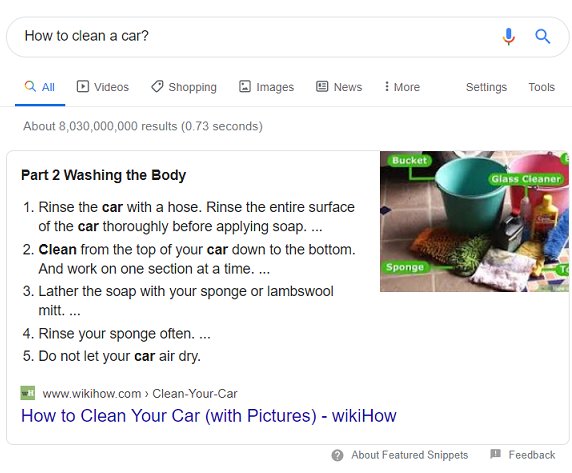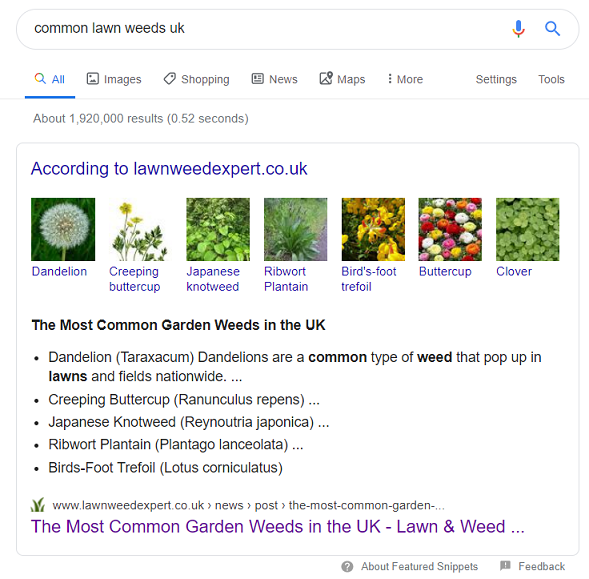
Search results are constantly changing and evolving so it’s important that marketers change their strategies if they want to achieve and maintain high rankings in the search engine results pages (SERPs).
Gone are the days where the SERPs are filled with hundreds of plain links. Now, featured snippets and local results are often the first things users see when using Google. But what impact are these features this having on website click-through rates? Let’s find out.
A Quick Introduction to Featured Snippets
We’re sure you’ve come across Google’s featured snippets before but, just in case, let’s quickly get you up to speed on what they are.
A featured snippet is a short summary of information from a trusted source or website that sits at the top of Google’s search engine results page (a position often referred to as ‘position zero’). Featured snippets appear above all other organic results and are shown for a wide range of questions, queries and keywords. They take up a huge section of the search results and might look something like this…

As you can see, typing ‘How to clean a car?’ into Google will show you a featured snippet with a step by step list of instructions and a labelled photograph. This quickly gives you all the information you need to get the job done, without requiring you to click through to a website. Helpful, right?
This isn’t the only style of featured snippet that we see in Google’s search results, in fact, there are 3 common types of featured snippets; paragraphs, lists and tables. Of these three types, paragraphs are by far the most common, currently making up around 80% of all featured snippets on Google.
Did you know that featured snippets are also the first point of reference for Google’s voice search results? With more and more smart devices and voice-activated assistants making their way into people’s homes, it’s clear to see why featured snippets are becoming more prominent in digital marketing strategies.
How Do Featured Snippets Impact Click-Through-Rates?
Google introduced featured snippets way back in 2014 to (in Google’s own words) “help people more easily discover what they’re seeking, both from the description and when they click on the link to read the page itself”.
Since featured snippets were introduced, SEO specialists have been increasingly concerned about their impact on click-through-rates. After all, why would users bother to click through to a website, if all the information they need can be found in the search results?
To tackle these concerns, Google adds a link to the source of the snippet of information prominently and cites the source website whenever Google Assistant reads it aloud as a spoken result. Google even sends a link to the Google Home app so users can ‘click to learn more’ if they so wish. But is this enough? How often do people click to learn more?
According to a recent study carried out by notorious SEO specialist, Rand Fishkin, “less than half of all Google searches now result in a click” (as shown in the chart above). Of course, this doesn’t mean that ranking highly is becoming less important, it just means that digital marketers need to be clever about generating content, adding schema markup to sites, and satisfying Google’s requirements if they want to gain maximum exposure in the search results.
Let’s take a look at a featured snippet we were able to gain for a client in 2019, to see whether gaining this top spot has had a positive, negative or no noticeable effect on click-through-rate.

This blog (shown above) ‘The Most Common Garden Weeds in the UK’ was published in March 2019. By mid-May, we started to see a huge spike in traffic to the website, and more specifically, a dramatic rise in the number of people visiting this blog.
A quick investigation found that this blog had been selected to sit in the exclusive ‘position zero’ for keywords related to common lawn weeds uk. (We gave ourselves a pat on the back).
Between the time the blog was published (March 29th) and the end of the year (December 31st) this blog single-handedly drove over 50% of all new users to the website, more than any other page on the website! The number of clicks through to the blog totalled an impressive 70% of all clicks through to the website, so the positive impact that this featured snippet had for our client was unprecedented.
When considering why that is, it’s likely that the topic that this snippet addresses is driving users to click through. The common garden weeds are listed in the featured snippet, but users might want to find out more information such as; when the weeds are most prevalent and how to get rid of them.
What Can We Take from This?
What this shows is that users are certainly becoming less likely to click on webpages and ads because, quite frankly, they no longer need to. Google is finding the information they need and presenting it to them in an easily digestible way.
However, what our client’s results show is that featured snippets are an incredibly valuable feature that can drive lots of people to your website. Gaining ‘position zero’ puts your site directly in front of the user, and if they do want to find out more, then it’s your site they’re most likely to visit.
It’s important to bear in mind that even users who don’t click on the featured snippet are still being exposed to your brand, whether that’s visually or audibly. This improved brand awareness and authoritative position can only have a positive impact on your business in the long-term.
So, gaining featured snippets is certainly something that business owners and digital marketers should aim for as part of their marketing strategy. You can read more about writing to gain featured snippets in one of our previous blogs.
How to Gain a Featured Snippet >
If you’d like help increasing brand awareness, boosting your Google rankings or keeping your website content fresh and up to date, find out more about our SEO team here.